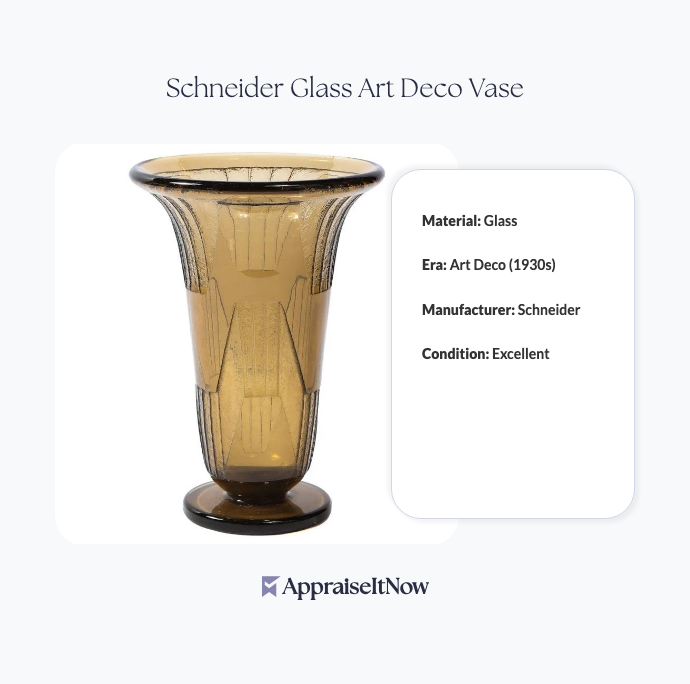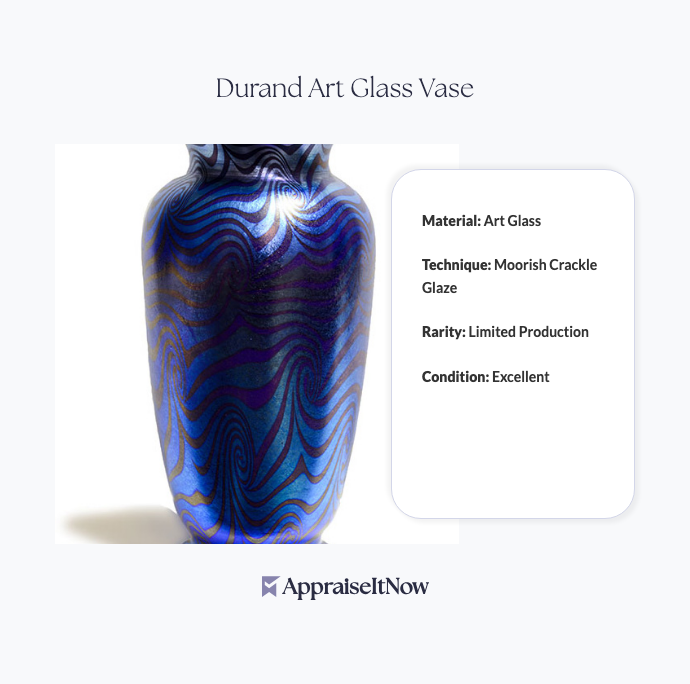<h1>How to Get Your Muller Frères Cameo Glass Vase Appraised</h1>
<p>If you've inherited, discovered, or acquired a Muller Frères cameo glass vase, understanding its market value requires more than a casual online search. These exceptional pieces of French art glass, valued between <strong>$2,500 and $4,000</strong>, demand professional expertise to accurately assess condition, authenticity, and provenance. Whether you're considering a sale, updating your insurance coverage, or simply curious about what you own, a certified appraisal provides the documentation and confidence you need.</p>
<h2>What Makes Muller Frères Cameo Glass Valuable</h2>
<p>The Muller Frères company, based in Lunéville, France, revolutionized decorative glassmaking in the late 19th century by perfecting the cameo glass technique—a method that layers colored glass and meticulously carves intricate designs into the surface. Your vase's value stems directly from this labor-intensive artistry combined with the studio's exceptional reputation in the broader landscape of fine glass and crystal. When collectors ask <em>what is special about cameos</em>, the answer lies in the technical difficulty and artistic vision: each piece represents hours of skilled handiwork that cannot be replicated by modern mass production.</p>
<div class="callout tip"><p><strong>Collector's Insight</strong></p>
<p>Only approximately 500 Muller Frères cameo glass vases were produced worldwide, making each example a genuinely rare piece of French decorative arts history.</p></div>
<p>The floral motifs that define authentic Muller Frères pieces showcase rich hues and subtle shading achieved through the layering technique. This distinguishes them from lesser-quality contemporary glasswork and explains why serious collectors actively seek these vases for their collections. Understanding the difference between mass-produced glassware and handcrafted art glass helps explain why your piece commands premium pricing in today's market.</p>
<h2>Understanding Cameo Glass Construction and Authenticity</h2>
<p><em>What is a cameo vase?</em> At its core, a cameo vase represents glass carving at its highest level—multiple colored glass layers bonded together, then expertly carved to reveal the contrasting colors beneath. The Muller Frères approach specifically involved layering colored glass over clear glass, creating dramatic visual depth and luminosity when light passes through the piece.</p>
<p>Authentic Muller Frères vases demonstrate several distinctive characteristics that appraisers examine during valuation. The carved designs typically feature natural motifs—trees, flowers, landscapes—executed with precision that shows the artist's hand rather than mechanical repetition. This human element matters tremendously when determining <em>how to tell if a cameo is an antique</em> versus a modern reproduction.</p>
<p>The construction method itself prevents casual duplication. Creating a successful cameo vase requires multiple specialized skills: glass formulation, layer bonding, design planning, and carving expertise. This complexity directly explains why <em>the most expensive type of glass</em> often involves cameo work, whether from Muller Frères, Gallé, or other renowned French studios.</p>
<div class="callout note"><p><strong>Authenticity Marker</strong></p>
<p>Genuine Muller Frères pieces typically bear a signature carved into the glass itself, usually reading "Muller Fres Lunéville" or similar variations. This mark, combined with quality assessment, forms the foundation of appraisal authentication.</p></div>
<h2>How Professional Appraisers Evaluate Your Vase</h2>
<p>When seeking a professional valuation through our <a href="/blog/appraising-fine-glass-and-crystal-valuing-delicate-glassware-and-artistic-creations">fine glass and crystal appraisal services</a>, appraisers follow established methodologies that examine multiple dimensions of your piece simultaneously.</p>
<p><strong>Condition assessment</strong> represents the first critical component. Appraisers evaluate whether your vase displays the "impeccable condition" referenced in the piece's provenance or shows signs of restoration, chips, cracks, or cloudiness. Minor surface wear typically affects value minimally—collectors expect some patina on century-old glass—but structural damage or heavy repairs can reduce worth by 20-40%. The question <em>how do I know if my vase is worth money</em> often hinges on whether damage is superficial or structural.</p>
<p><strong>Design analysis</strong> examines the specific floral motif, carving precision, and color palette. More complex designs with multiple colored layers or exceptional artistry command premiums. Appraisers compare your piece against documented examples to establish whether the design represents a known pattern or unique variant—rare designs consistently achieve higher valuations.</p>
<p><strong>Documentation review</strong> investigates any available historical records. Sales receipts, provenance statements, exhibition catalogs, or family histories significantly enhance credibility and value. Even informal documentation—family records noting acquisition dates or locations—provides valuable context that professional appraisers incorporate into their reports. Our guidance on <a href="/blog/exploring-the-role-of-provenance-in-art-appraisals-assessing-historical-significance">exploring provenance in art appraisals</a> explains how historical documentation transforms valuation outcomes.</p>
<p><strong>Market comparison</strong> places your specific vase within the $2,500-$4,000 range by analyzing recent sales of comparable pieces. Appraisers access auction records, dealer catalogs, and private transaction data to establish where your particular example sits within the market spectrum. A first-introduced 1890s example in exceptional condition with perfect provenance may reach $4,000, while later variants or pieces with restoration history might appraise toward $2,500.</p>
<h2>Key Specifications That Impact Your Appraisal Value</h2>
<p>The timeline of manufacture significantly influences Muller Frères valuations. Pieces from the 1890s-1900s period when the technique was perfected command higher prices than later examples produced into the early 20th century. Your vase's manufacturing date, if determinable through design characteristics or documentation, directly affects its appraised value.</p>
<p>The specific colors and layering technique employed matter considerably. Vases with rare color combinations—rich purples, deep blues, or complex multi-color layering—typically achieve premiums over more common amber or green examples. When collectors wonder <em>what is the rarest vintage glass color</em>, the answer often points to unusual color combinations in French art glass that reflect experimental production periods.</p>
<p>Size represents another practical consideration. Most Muller Frères cameo vases range from 4-8 inches in height, with larger examples commanding proportional premiums due to the increased difficulty of production and display impact. Unusually large pieces showing perfect execution represent exceptional acquisitions for serious collectors.</p>
<h2>Valuation Factors: Beyond the Basic Description</h2>
<p>Understanding what affects your vase's final appraised value requires looking past simple categorization. The floral motif's complexity matters tremendously—a simple single-flower design differs substantially in execution and value from an elaborate landscape scene incorporating trees, water, and atmospheric perspective. Appraisers skilled in <a href="/blog/understanding-artwork-appraisals">understanding artwork appraisals</a> recognize these nuances immediately.</p>
<p>The carving depth and surface finish quality indicate the artist's skill level and the original studio's investment in the piece. Muller Frères maintained high standards, but individual artists within the studio produced work at slightly different skill levels. Fine, precise carving with clean lines suggests execution by senior artisans, while slightly rougher work might reflect apprentice contributions—both are authentic, but they value differently.</p>
<p>Light transmission represents an underappreciated quality assessment criterion. A well-executed cameo vase should display translucent quality when held to light, showing how the layered glass interacts with illumination. Cloudiness, yellowing, or opacification can indicate chemical changes in the glass itself or internal cracks—conditions that appraisers document carefully as they affect both beauty and value.</p>
<p>The original context—whether your vase was part of a matched pair, a series, or a documented exhibition—adds substantial value. A vase with exhibition history or provenance linking it to significant collectors or institutions may appraise 20-30% higher than a comparable piece with unknown history.</p>
<div class="callout tip"><p><strong>Preparation Tip</strong></p>
<p>Gather any documentation about your vase's acquisition—receipt information, family records, insurance paperwork, or exhibition catalogs. This material helps appraisers establish context and can increase the appraised value.</p></div>
<h2>Identifying Your Vase's Authenticity and Origin</h2>
<p>The question <em>how do I know if my glass vase is valuable?</em> begins with confirming it's genuinely a Muller Frères creation rather than a contemporary work from another studio or a later reproduction. Professional appraisers employ several verification methods that go far beyond the visible signature.</p>
<p>Examining the carved signature itself—its style, depth, and placement—provides crucial authenticity clues. Muller Frères signatures evolved throughout the company's production period; appraisers familiar with these variations can date pieces and spot modern forgeries. The signature should appear naturally integrated into the design rather than crudely applied.</p>
<p>Glass composition analysis represents another authentication layer. Original late-19th-century French art glass displays specific chemical characteristics that differ from modern glass formulations. Professional appraisers can reference known examples and assess whether your piece's glass chemistry aligns with documented Muller Frères production standards.</p>
<p>Design comparison against known catalogs and museum examples provides definitive verification. If your vase's design matches a documented pattern from the Muller Frères archive or appears in museum collections, authentication becomes straightforward. Conversely, unique designs require more careful evaluation but may represent special commissions—potentially valuable in their own right.</p>
<h2>The Appraisal Process Explained</h2>
<p>When you decide to pursue professional appraisal through AppraiseItNow or similar services, expect a structured process designed to establish your vase's fair market value with confidence. Professional appraisers provide comprehensive documentation suitable for insurance purposes, estate settlements, or sale transactions.</p>
<p>The initial consultation allows you to discuss your vase's history, your appraisal purpose (insurance, estate, sale), and any specific questions you have. This conversation helps the appraiser understand context and tailor their evaluation approach.</p>
<p>The physical examination follows, where the appraiser inspects your vase comprehensively, noting condition, dimensions, weight, construction details, and any distinguishing features. Professional appraisers photograph the piece from multiple angles, documenting markings, surface condition, and design details for the written report.</p>
<p>Comparative market analysis provides the valuation foundation. Appraisers research recent sales of comparable Muller Frères pieces, consult dealer catalogs, and review auction results to establish your piece's position within the $2,500-$4,000 market range. This data-driven approach ensures valuations reflect current market conditions rather than outdated estimates.</p>
<p>The final report documents all findings in a USPAP-compliant format that insurance companies, auction houses, and legal professionals recognize and accept. This professional documentation—the core value of appraisal services—provides confidence for all parties involved in valuation-dependent decisions.</p>
<h2>Finding the Right Appraiser for Your Muller Frères Vase</h2>
<p>Not all appraisers possess expertise in French art glass or cameo techniques. When selecting a professional, verify their specific experience with fine glass, art glass, or decorative arts. Appraisers credentialed by organizations like AAA, ISA, ASA, CAGA, or AMEA demonstrate commitment to professional standards and ongoing education in their specialty areas.</p>
<p>Experience matters tremendously. An appraiser who has previously valued Muller Frères pieces, examined comparable examples, and understands the nuances of cameo glass construction will provide more reliable, detailed valuation than a generalist. Ask potential appraisers about their specific experience with this French studio and similar art glass.</p>
<p>The appraisal report quality distinguishes professional services from casual estimates. Comprehensive written reports include detailed descriptions, condition assessments, comparable sales analysis, high-quality photography, and clearly stated methodology. This documentation protects both your interests and provides credibility if valuations are later questioned or tested.</p>
<p>Accessibility to online appraisal services through platforms like AppraiseItNow simplifies the process considerably. You can submit photographs, descriptions, and documentation securely online and receive certified appraisals from credentialed experts specializing in <a href="/blog/understanding-artwork-appraisals">artwork appraisals</a>. This approach works particularly well for objectively photographable items like your vase.</p>
<h2>Insurance and Estate Planning Considerations</h2>
<p>A certified appraisal becomes essential if you're insuring your Muller Frères vase. Homeowner's policies typically include limited coverage for collectibles; items valued above these limits require separate fine arts or scheduled personal property coverage. Your appraiser's documentation provides the agreed-upon value that insurance companies use to establish premium costs and replacement benefit levels.</p>
<p>For estate planning purposes, appraisals ensure fair distribution among heirs and provide tax authorities with documented valuation if your estate requires professional assessment. This protects both your wishes and your family's interests by establishing clear, professional documentation of asset values.</p>
<p>When preparing your vase for sale through auction houses or private dealers, current professional appraisals help establish realistic asking prices and guide marketing strategies. Auctioneers particularly value comprehensive appraisal reports that help establish provenance and justify estimate ranges to potential bidders.</p>
<div class="callout note"><p><strong>Key Takeaway</strong></p>
<p>A certified appraisal of your Muller Frères cameo glass vase provides essential documentation for insurance coverage, estate planning, and sale purposes, ensuring you understand both the historical significance and monetary value of this exceptional piece of French decorative arts.</p></div>







.avif)







